Ukraine Waffen: Atacms Taurus Scalp

Discover more detailed and exciting information on our website. Click the link below to start your adventure: Visit Best Website Ukraine Waffen: Atacms Taurus Scalp. Don't miss out!
Table of Contents
Ukraine Waffen: ATACMS, Taurus, SCALP – A Deep Dive into Western Weaponry
Hey everyone, so you're curious about the weapons systems flowing into Ukraine? Yeah, it's a crazy complex situation, and honestly, I've spent hours – maybe even days – trying to wrap my head around it all. Let me share what I've learned, warts and all. I'm no military expert, just a guy who's been following this closely and trying to make sense of it all.
ATACMS: The Long-Arm Punch
Okay, so ATACMS, or Army Tactical Missile System, right? These are serious long-range missiles. We're talking hundreds of kilometers – way beyond the range of most of Ukraine's existing artillery. Think of them as a really, really powerful punch that can reach deep into Russian-held territory.
My initial thought? "Wow, game-changer!" But then I started digging deeper. The logistics of deploying and maintaining these things are intense. You need specialized launchers, trained personnel, and constant supply lines for ammo and parts. It's not just about giving Ukraine a few missiles; it's about building up an entire support infrastructure. And that takes time, which, in a war, can be a luxury you don't have. I initially underestimated the complexities. Big mistake!
Taurus KEPD 350: Precision from Afar
The Taurus KEPD 350 is a different beast altogether. It's a long-range cruise missile designed for pinpoint accuracy. The idea is to take out high-value targets like command centers or bridges, minimizing civilian casualties. I've read articles suggesting that it's got some seriously advanced guidance systems, allowing it to even adjust its trajectory mid-flight to compensate for unexpected circumstances – that’s pretty darn cool. But let's be real; these babies aren't cheap. The cost per missile is a big factor influencing delivery speed. And, again, you need the right training and support for effective deployment.
SCALP EG/Storm Shadow: A European Contender
Then there's the SCALP EG/Storm Shadow. Basically, it's another long-range cruise missile. It's similar in its capabilities to the Taurus, although some sources say its range is slightly longer, and its stealth capabilities are particularly interesting. What gets me though, is the political implications. Different countries are contributing different weapon systems, and that coordination…well, it can be messy, to say the least. It highlights the complexity of international cooperation in a time of war.
The Bigger Picture: More Than Just Weapons
These weapon systems, ATACMS, Taurus, and SCALP, aren't just about the hardware itself. It's about the entire support ecosystem: training, maintenance, logistics, and intelligence sharing. Getting these things right is just as crucial – perhaps more crucial – than the weapons themselves. I mean, a super-advanced missile is useless if you can't get it to the right place at the right time. That’s a lesson I learned the hard way. Initially I focused solely on the weapons’ specs, overlooking the logistical factors. Don’t make that same mistake!
What's Next? The Ongoing Debate
The debate about supplying even more advanced weaponry to Ukraine is far from over. There are arguments for and against – concerns about escalating the conflict, the risk of unintended consequences, and the sheer cost involved. It's a tough call with no easy answers, and I don't pretend to have all the solutions. It’s a dynamic situation, constantly evolving. The one thing I know for sure is that I'll keep learning and keep sharing what I discover. Maybe you can help fill in the gaps I've missed!
This article attempts to cover ATACMS, Taurus KEPD 350, and SCALP EG/Storm Shadow in an informative and approachable manner using personal anecdotes and insights, integrating relevant keywords, and using a casual conversational tone. Remember that the specifics of military capabilities are often classified or subject to change. Always refer to official sources for the most up-to-date information.

Thank you for visiting our website wich cover about Ukraine Waffen: Atacms Taurus Scalp. We hope the information provided has been useful to you. Feel free to contact us if you have any questions or need further assistance. See you next time and dont miss to bookmark.
Featured Posts
-
Politik Und Jugend Kriminalitaet Steigen
Nov 21, 2024
-
Bezahlte Spenden Bleiben Erlaubt
Nov 21, 2024
-
Woodward Maischberger Putin Vergleich Hitler
Nov 21, 2024
-
Stark Veraengstigte Kate Middleton William Half
Nov 21, 2024
-
James Bond 26 Neue Aera
Nov 21, 2024
